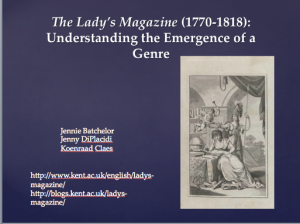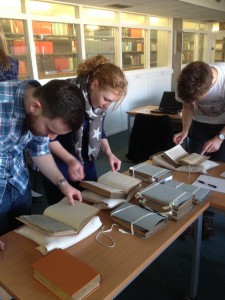We are now, somewhat unbelievably, heading towards the six-month mark of our two-year project. The index is progressing very well, the methodological quandaries its composition has posed are being worked through, and we are getting ever closer to a sense of what this magazine was really all about and why it was so popular and enduring.
But up until this point, we have have mainly been talking about the magazine amongst ourselves. Enjoyable though this has been, we felt the time was right to start taking the project to people to gain feedback and to see what questions about the magazine people most wanted answered. In the past couple of weeks we have been doing just that and it has been truly illuminating and a good deal of fun.
 Our first big public presentation of the research project took place on the 4 March at the University of Kent as part of the School of English’s ongoing research seminar series. Trying to whittle down our respective roles in the project to just 12 minutes each was quite a challenge, but it certainly focused the mind. I began by talking about my 15-year fascination with the magazine and my sense of why it had not yet received the scholarly attention or been accorded the critical literary-historical importance I felt it deserved. I then handed over to Jenny who talked about and demonstrated a part of the index in action and elucidated her herculean efforts to catalogue each and every one of the many thousands of items in the magazine over its first 50 years by genre, subgenre and keyword. Finally, Koenraad delivered fascinating insights into the methods he is using to profile individual contributors (the vast majority of whom go by pseudonyms) and to make attributions where they might be possible. We were delighted with the feedback we got and the genuine interest the magazine and project seemed to generate from colleagues working in all periods and across different genres. Its a talk that we will be giving in a slightly different form at Chawton House Library in May if you would like to come and hear it then.
Our first big public presentation of the research project took place on the 4 March at the University of Kent as part of the School of English’s ongoing research seminar series. Trying to whittle down our respective roles in the project to just 12 minutes each was quite a challenge, but it certainly focused the mind. I began by talking about my 15-year fascination with the magazine and my sense of why it had not yet received the scholarly attention or been accorded the critical literary-historical importance I felt it deserved. I then handed over to Jenny who talked about and demonstrated a part of the index in action and elucidated her herculean efforts to catalogue each and every one of the many thousands of items in the magazine over its first 50 years by genre, subgenre and keyword. Finally, Koenraad delivered fascinating insights into the methods he is using to profile individual contributors (the vast majority of whom go by pseudonyms) and to make attributions where they might be possible. We were delighted with the feedback we got and the genuine interest the magazine and project seemed to generate from colleagues working in all periods and across different genres. Its a talk that we will be giving in a slightly different form at Chawton House Library in May if you would like to come and hear it then.
Then just two days later we got an opportunity to revisit the project from a different point of view by participating in a wonderful Material Witness workshop series for CHASE (Consortium of the Humanities and the Arts in South-East England) doctoral training initiative at Kent. Our topic was ‘Text as Object’ and our focus was working on and between digital copies of eighteenth and nineteenth century periodicals and the originals. The event was co-run by our colleague Professor Cathy Waters and we were very fortunate to have been joined by Professor John Drew from the University of Buckingham and founder of the groundbreaking Dickens Journals Online. A dedicated post on the day as a whole will follow soon on the Material Witness blog, but I couldn’t resist sharing some of our experiences from the day here.
Kent has very few copies of the Lady’s Magazine in its Special Collections, but it does have one fine bound volume and, incredibly, one unbound monthly copy. In fact, it is the only unbound monthly copy, with its original covers, I have seen in 15 years of working with this material. The workshop participants – all doctoral students from across the CHASE consortium – could handle this material, alongside copies of La Belle Assemblee (with which handsome title the Lady’s Magazine would eventually merge) and all had complete access to the Adam Matthews digitisation of the magazine’s complete run.
We had one dedicated slot in the day to get students working with the magazine in its digital form (after an earlier session handling the originals). The question was what to do with it. We have lots to say about the magazine, of course, and could easily have filled 30 minutes telling everyone how important we think the magazine is. Instead, we opted for a different approach. Much to the bemusement of many of the participants we set them up with a laptop each and gave them a simple instruction. They had 10 minutes to read the Lady’s Magazine and tell us what they thought about it.
Of course we were interested in their thoughts and observations (most of which were about the magazine’s readers and writers) but the exercise was a sleight of hand on our part designed to find out how individuals (chose to) read the magazine in digital form. Where do you start? Which year? And once you have a year, do you read from front to back or do you go to the index at the back of the bound volumes or the contents pages at the start of each month? Or do you search for particular keywords? Is this anything like we imagine the reading experience would have been for eighteenth-century readers or even our own if we had the original material copies in our hands? Do the differences matter and why? It was a fascinating conversation and we could have continued for much longer than we had time for.
 We’ll take up some of these questions and lines of conversation in a future post. But the thing that I will most happily take from the day is something I hadn’t really thought about in advance of it. As we sat there at the front of the room watching nearly 20 people sat reading the Lady’s Magazine, some furiously making notes, some smiling, some talking to colleagues about particularly interesting content, it struck me: we had a group of nearly 20 people reading and engaging with the content of the Lady’s Magazine! I whipped out my iPhone and started taking lots of photos to commemorate the occasion.
We’ll take up some of these questions and lines of conversation in a future post. But the thing that I will most happily take from the day is something I hadn’t really thought about in advance of it. As we sat there at the front of the room watching nearly 20 people sat reading the Lady’s Magazine, some furiously making notes, some smiling, some talking to colleagues about particularly interesting content, it struck me: we had a group of nearly 20 people reading and engaging with the content of the Lady’s Magazine! I whipped out my iPhone and started taking lots of photos to commemorate the occasion.
Because ultimately this is what this project is about. Yes we have articles we want and need to write and I have a book I want and need to write, but our main goal is to get people reading the magazine again and to help them navigate it. It was a great moment and one I hope we will get to replicate again in the near future.
Dr Jennie Batchelor
School of English
University of Kent

